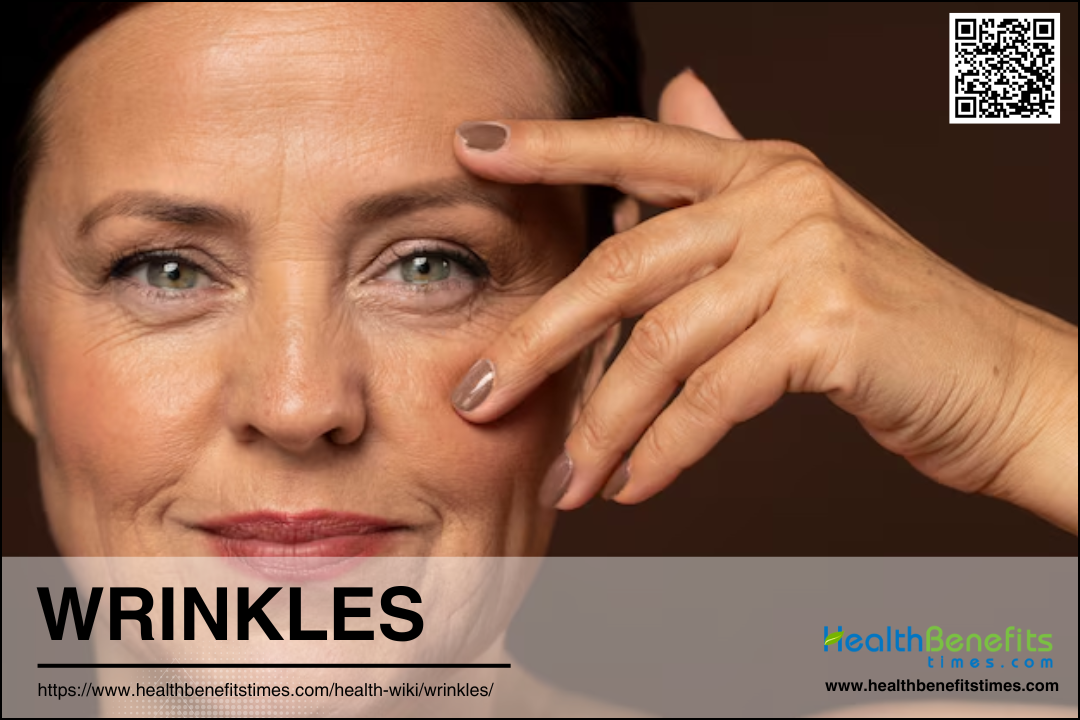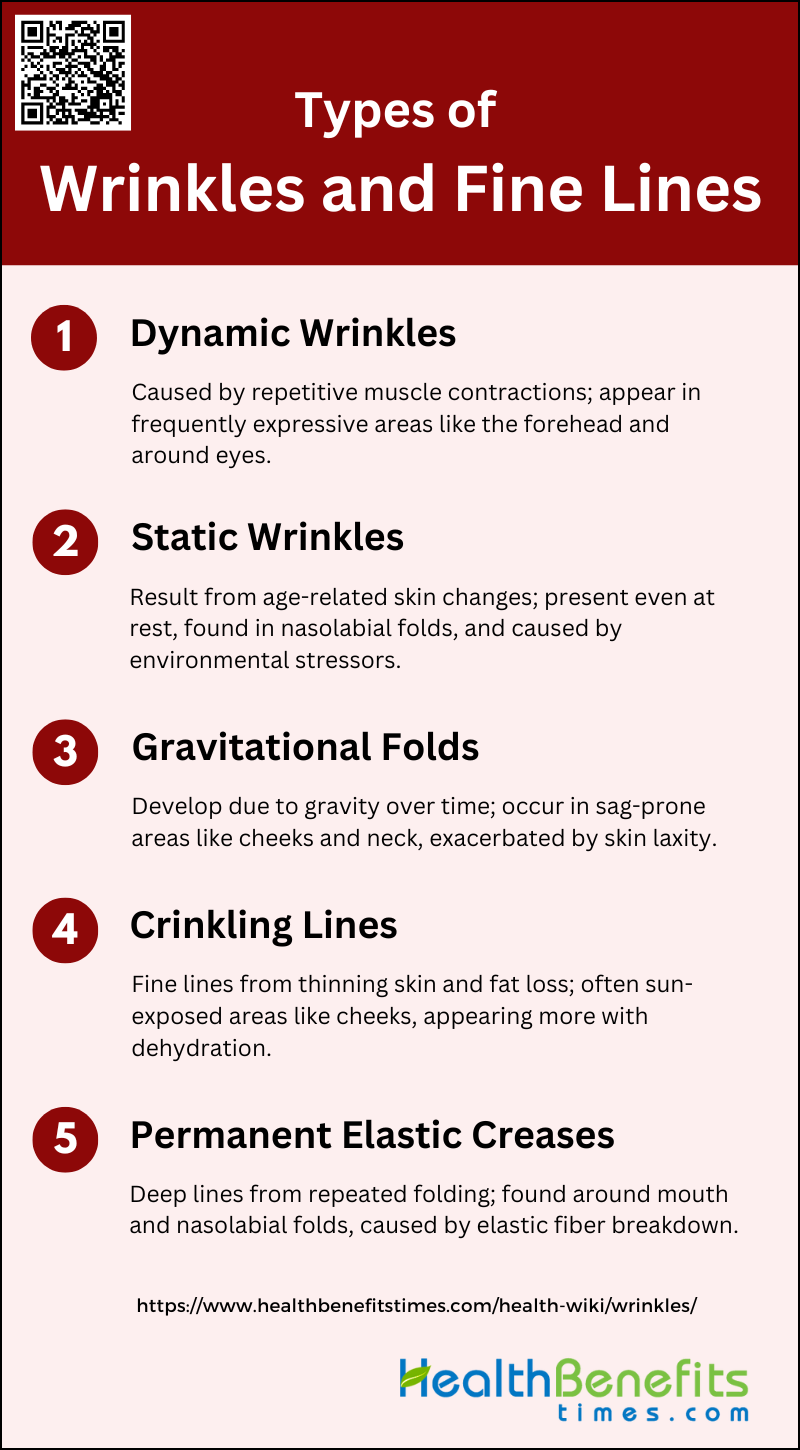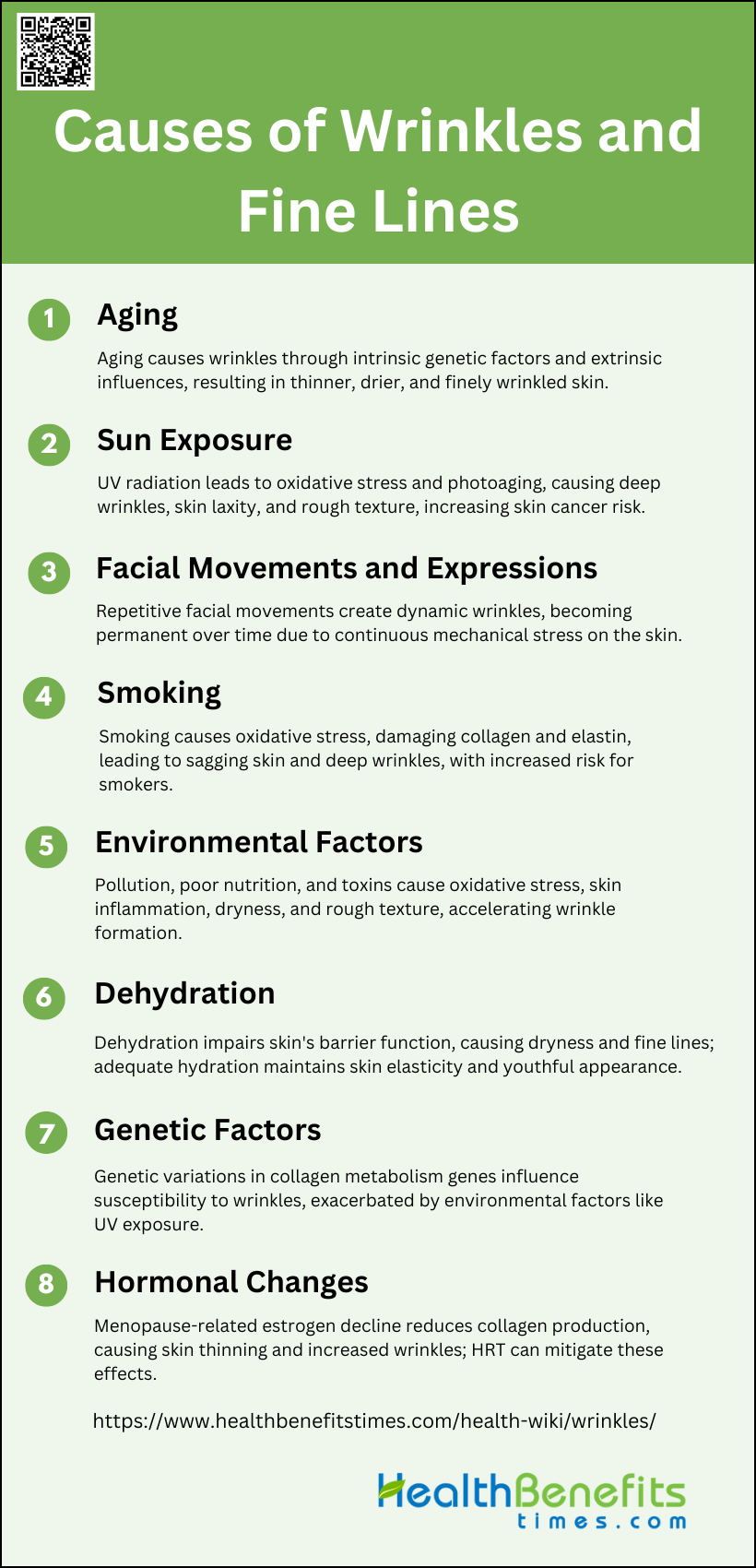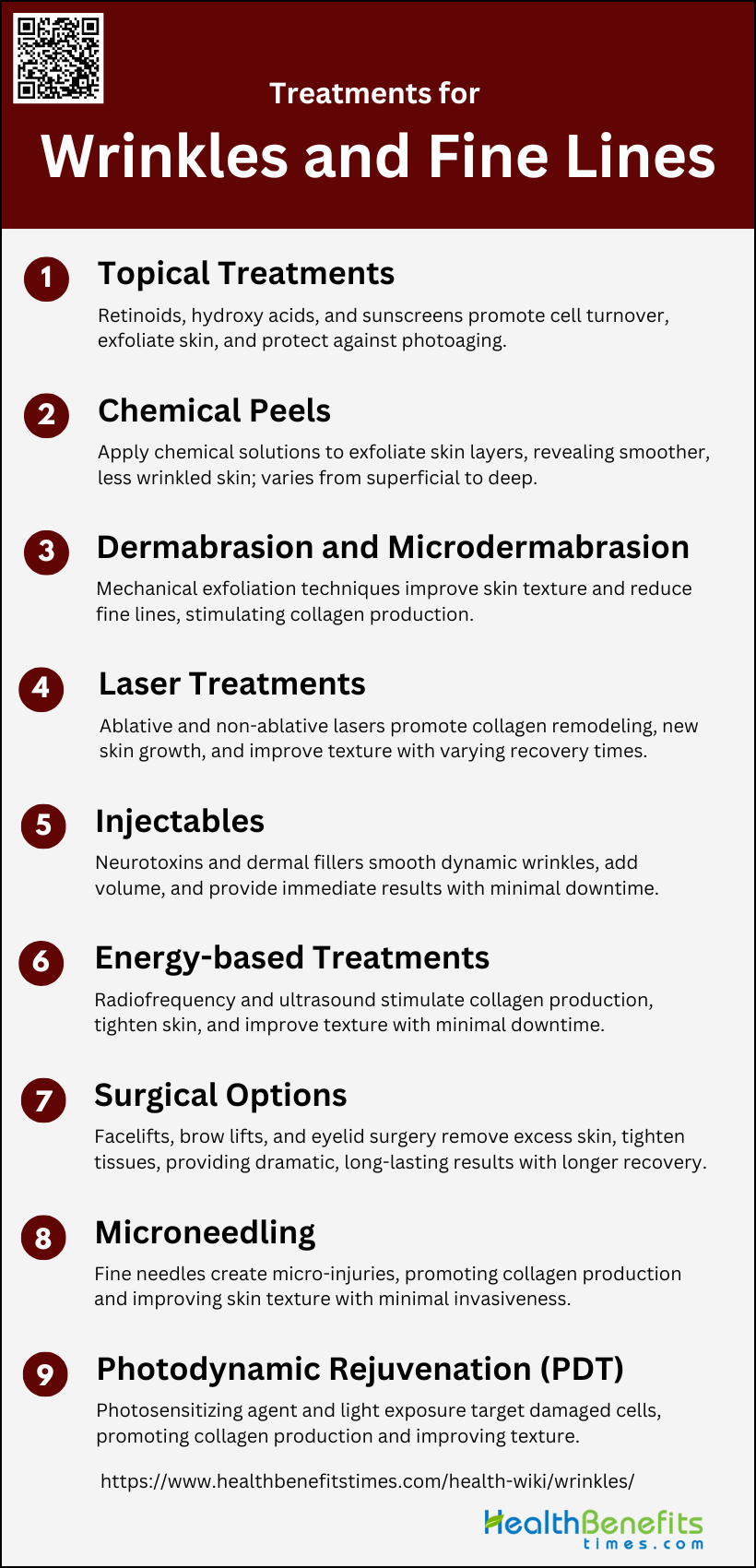Wrinkles are lines and creases that form on the skin as a natural part of the aging process. They are primarily caused by a combination of intrinsic aging, which includes genetic factors and the natural decline in collagen and elastin production, and extrinsic aging, which encompasses environmental factors such as sun exposure, smoking, and pollution. Dynamic wrinkles, which appear during facial movements, and static wrinkles, which are visible even when the face is at rest, are the two main types. Treatments for wrinkles include topical retinoids, laser therapies, and injectable solutions like botulinum toxin (Botox) and hyaluronic acid fillers, which can temporarily reduce their appearance by relaxing facial muscles or adding volume to the skin.
What is Fine Lines?
Fine Lines refer to the early, subtle wrinkles that appear on the skin, typically as a result of aging, sun exposure, and repetitive facial expressions. These lines are usually shallow and less pronounced than deeper wrinkles, often forming around the eyes, mouth, and forehead. Fine lines are a natural part of the aging process as the skin loses its elasticity and collagen production decreases. While they are generally less noticeable than more pronounced wrinkles, they can be a cosmetic concern for many individuals seeking to maintain a youthful appearance. Various skincare treatments, such as moisturizers, retinoids, and cosmetic procedures like microdermabrasion and laser therapy, are often employed to reduce the appearance of fine lines.
How fine lines differ from wrinkles?
Fine lines and wrinkles, though often used interchangeably, differ in their formation and appearance. Fine lines are typically shallow and appear as the initial signs of aging, often resulting from repetitive facial movements and a decrease in skin elasticity and collagen production. They are usually less than 1 millimeter in depth and are most noticeable around the eyes and mouth. Wrinkles, on the other hand, are deeper and more pronounced, forming as a result of more significant structural changes in the skin, including the breakdown of collagen and elastin fibers, and are often exacerbated by prolonged sun exposure and other environmental factors. While fine lines can be addressed with topical treatments that stimulate collagen production, such as palmitoyl pentapeptide, wrinkles may require more intensive interventions like microneedling or prescription treatments to achieve noticeable improvements.
Types of wrinkles and fine lines
Wrinkles and fine lines are common signs of aging that can appear on various parts of the face and body. They are caused by a combination of factors including genetics, sun exposure, and lifestyle choices. Below are the different types of wrinkles and fine lines you should know about:
1. Dynamic Wrinkles
Dynamic wrinkles, also known as expression lines, are primarily caused by the repetitive contraction of facial muscles. These wrinkles are most commonly found in areas of the face that are frequently used for expressions, such as the forehead, around the eyes (crow’s feet), and between the eyebrows (glabellar lines). The underlying mechanism involves the compression of skin due to muscle contraction, which over time leads to the formation of visible lines and folds. Unlike other types of wrinkles, dynamic wrinkles are more pronounced when the facial muscles are in motion and may become less noticeable when the face is at rest.
2. Static Wrinkles
Static wrinkles are primarily the result of age-related changes in the skin, including the loss of collagen, elastin, and hyaluronic acid, which contribute to the skin’s structural integrity and elasticity. These wrinkles are present even when the facial muscles are at rest and are often found in areas such as the nasolabial folds, marionette lines, and perioral wrinkles. The formation of static wrinkles is influenced by factors such as prolonged exposure to UV radiation, smoking, and other environmental stressors that accelerate the degradation of skin components. Unlike dynamic wrinkles, static wrinkles are permanent and do not disappear with changes in facial expression.
3. Gravitational Folds
Gravitational folds are wrinkles that develop due to the effects of gravity on the skin over time. As the skin ages, it loses its elasticity and becomes more susceptible to sagging, leading to the formation of deeper folds and creases. These wrinkles are typically found in areas where the skin is naturally looser, such as the cheeks, jawline, and neck. The gravitational force causes the skin to fold and crease, especially in regions where the underlying support structures, such as fat and connective tissue, have diminished. Gravitational folds are often more pronounced in individuals with significant skin laxity and are a common target for cosmetic and surgical interventions.
4. Crinkling Lines
Crinkling lines, also known as atrophic crinkling rhytids, are fine lines that appear as a result of the thinning of the skin and the loss of underlying fat and connective tissue. These lines are often seen in areas that are frequently exposed to the sun, such as the cheeks and around the eyes. The skin in these areas becomes more fragile and less able to retain moisture, leading to a crinkled appearance. Crinkling lines are typically shallow and may be more noticeable when the skin is dehydrated. They are often treated with moisturizing agents, retinoids, and other skin-rejuvenating treatments to improve skin texture and hydration.
5. Permanent Elastic Creases
Permanent elastic creases are deep, persistent lines that form in areas of the skin that are subject to repeated folding and movement. These creases are often found in regions such as the nasolabial folds, marionette lines, and the lines around the mouth. The formation of these creases is due to the breakdown of elastic fibers in the skin, which reduces the skin’s ability to return to its original shape after being stretched or compressed. Over time, these creases become more pronounced and permanent, contributing to the aged appearance of the skin. Treatments for permanent elastic creases often include dermal fillers, laser therapy, and other cosmetic procedures aimed at restoring skin elasticity and volume.
Causes of Wrinkles and Fine Lines
Wrinkles and fine lines are primarily caused by the breakdown of collagen and elastin in the skin. Factors such as sun exposure, smoking, and repetitive facial expressions can accelerate this process. Here are the main causes of wrinkles and fine lines:
1. Aging
Aging is a primary cause of wrinkles and fine lines, driven by both intrinsic and extrinsic factors. Intrinsic aging is a genetically programmed process that leads to the degeneration of skin tissues, hormonal changes, and a reduced ability to repair skin damage. This results in thin, dry, and finely wrinkled skin, particularly in sun-protected areas. The decline in physiological hormones with age also plays a significant role in skin aging, affecting DNA repair, mitochondrial function, and cellular metabolism. Understanding these molecular mechanisms can help develop strategies to mitigate age-related skin changes.
2. Sun Exposure
Sun exposure is a major extrinsic factor contributing to skin aging, often referred to as photoaging. Ultraviolet (UV) radiation from the sun causes oxidative stress, leading to the production of reactive oxygen species (ROS) that damage skin cells and accelerate aging. Photoaged skin is characterized by deep wrinkles, laxity, and rough texture, in contrast to the fine lines seen in chronologically aged skin. Prolonged sun exposure also increases the risk of skin cancer, making sun protection crucial for maintaining youthful skin.
3. Facial Movements and Expressions
Facial movements and expressions significantly contribute to the formation of wrinkles, particularly dynamic or hyperkinetic lines. These wrinkles result from repetitive muscle actions, such as frowning or smiling, which create lines in specific facial regions like the forehead, glabella, and crow’s feet. Over time, these expression lines can become permanent due to the continuous mechanical stress on the skin. Treatments like Botulinum toxin (Botox) can temporarily reduce these wrinkles by relaxing the underlying muscles.
4. Smoking
Smoking is an independent risk factor for premature facial wrinkling. The toxins in cigarette smoke cause oxidative stress and damage collagen and elastin fibers, leading to skin sagging and deep wrinkles. Studies have shown that smokers are significantly more likely to develop moderate to severe wrinkles compared to non-smokers, with the risk increasing with the number of pack-years smoked. Smoking cessation and protective measures like hormone replacement therapy (HRT) in postmenopausal women can help mitigate these effects.
5. Environmental Factors
Environmental factors such as pollution, poor nutrition, and exposure to toxins also contribute to skin aging. These factors exacerbate oxidative stress, leading to the production of ROS that damage skin cells and accelerate the aging process. Pollution and toxins can cause skin inflammation, dryness, and a rough texture, further promoting the formation of wrinkles and fine lines. Adopting a healthy lifestyle and using protective skincare products can help counteract these environmental impacts.
6. Dehydration
Dehydration affects the skin’s ability to maintain its barrier function, leading to dryness and the formation of fine lines. Adequate water intake is essential for maintaining skin hydration and elasticity. Dehydrated skin appears dull and is more prone to wrinkling, especially in individuals with a high polygenetic risk score (PRS) for collagen metabolism-related wrinkles. Ensuring sufficient hydration can help maintain skin’s youthful appearance and reduce the risk of wrinkle formation.
7. Genetic Factors
Genetic factors play a crucial role in determining an individual’s susceptibility to wrinkles and fine lines. Variations in genes related to collagen metabolism, such as EGFR, MMP16, and COL17A1, can significantly increase the risk of developing wrinkles. Individuals with a high PRS for these genetic variants are more likely to experience severe wrinkling, especially when combined with environmental factors like UV exposure and low water intake. Understanding these genetic predispositions can help in developing personalized skincare strategies.
8. Hormonal Changes
Hormonal changes, particularly during menopause, significantly impact skin aging. The decline in estrogen levels leads to reduced collagen production, skin thinning, and increased wrinkle formation. Hormone replacement therapy (HRT) has been shown to improve skin elasticity and reduce wrinkles in postmenopausal women, although its effectiveness may be limited in smokers. Managing hormonal changes through medical interventions and lifestyle modifications can help mitigate their impact on skin aging.
Prevention of Wrinkles and Fine Lines
Preventing wrinkles and fine lines involves a combination of good skincare practices and healthy lifestyle choices. Regular use of sunscreen, a balanced diet, and avoiding smoking can significantly reduce the appearance of these signs of aging. Here are some effective ways to prevent wrinkles and fine lines:
1. Protect Yourself from the Sun
Sun exposure is one of the leading causes of wrinkles and fine lines. To protect your skin, wear sunscreen with at least SPF 30 every day, even on cloudy days. Opt for broad-spectrum formulas to shield against both UVA and UVB rays. Additionally, wear protective clothing, such as wide-brimmed hats and sunglasses, and seek shade whenever possible. By minimizing sun exposure, you can significantly reduce the risk of premature aging and maintain a youthful complexion.
2. Use Retinoids
Retinoids, derivatives of vitamin A, are powerful anti-aging agents that can reduce the appearance of wrinkles and fine lines. They work by promoting cell turnover and stimulating collagen production, which helps to keep the skin firm and smooth. Available in both prescription and over-the-counter formulations, retinoids should be introduced gradually to avoid irritation. Consistent use can lead to noticeable improvements in skin texture and tone, making them a staple in any anti-aging skincare routine.
3. Moisturize
Keeping your skin well-moisturized is essential for preventing wrinkles and fine lines. Moisturizers help to maintain the skin’s natural barrier, locking in hydration and keeping the skin plump and supple. Look for products containing hyaluronic acid, glycerin, and ceramides, which are effective at attracting and retaining moisture. Applying moisturizer twice daily, especially after cleansing, can help to smooth out fine lines and create a more youthful appearance.
4. Stay Hydrated
Hydration is crucial for maintaining healthy, youthful skin. Drinking plenty of water throughout the day helps to keep the skin hydrated from the inside out, reducing the appearance of fine lines and wrinkles. Aim for at least eight glasses of water daily, and consider incorporating hydrating foods like cucumbers, watermelon, and oranges into your diet. Proper hydration supports overall skin health, making it more resilient and less prone to aging.
5. Eat a Vitamin-Rich Diet
A diet rich in vitamins and antioxidants can significantly impact the health and appearance of your skin. Vitamins A, C, and E are particularly beneficial for preventing wrinkles and fine lines. These nutrients help to protect the skin from oxidative stress, promote collagen production, and repair damaged skin cells. Incorporate a variety of colorful fruits and vegetables, nuts, seeds, and lean proteins into your meals to ensure your skin receives the essential nutrients it needs to stay youthful and vibrant.
6. Avoid Smoking
Smoking accelerates the aging process and contributes to the formation of wrinkles and fine lines. The toxins in cigarette smoke damage collagen and elastin, the fibers that give your skin its strength and elasticity. Additionally, the repetitive facial expressions made while smoking can lead to the development of fine lines around the mouth. Quitting smoking not only benefits your overall health but also helps to preserve your skin’s youthful appearance.
7. Manage Stress
Chronic stress can take a toll on your skin, leading to the development of wrinkles and fine lines. Stress triggers the release of cortisol, a hormone that can break down collagen and elastin, resulting in premature aging. To manage stress, incorporate relaxation techniques such as meditation, yoga, or deep breathing exercises into your daily routine. Taking time to unwind and practice self-care can help to keep your skin looking youthful and radiant.
8. Sleep on Your Back
Sleeping on your back can help to prevent the formation of sleep lines, which can eventually turn into permanent wrinkles. When you sleep on your side or stomach, your face is pressed against the pillow, causing creases and lines to form. By sleeping on your back, you minimize pressure on your face and allow your skin to rest in a natural, relaxed position. Investing in a silk pillowcase can also reduce friction and help to keep your skin smooth and wrinkle-free.
Treatments for Wrinkles and Fine Lines
Treating wrinkles and fine lines often requires a combination of skincare products and professional treatments. Options range from topical creams to advanced procedures like laser therapy and injectables. Here are some effective treatments for wrinkles and fine lines:
1. Topical Treatments
Topical treatments for wrinkles and fine lines often include retinoids, hydroxy acids, and bleaching agents. These treatments work by promoting cell turnover, exfoliating the skin, and reducing pigmentation irregularities. Retinoids, such as tretinoin, are particularly effective in improving skin texture and reducing fine lines by stimulating collagen production. Hydroxy acids, like glycolic acid, help in exfoliating the outer layer of the skin, revealing fresher, smoother skin underneath. Sunscreens are also crucial in preventing further photoaging by protecting the skin from harmful UV rays.
2. Chemical Peels
Chemical peels involve the application of a chemical solution to the skin, which causes the outer layer to exfoliate and eventually peel off. This process reveals new, regenerated skin that is typically smoother and less wrinkled. Chemical peels can vary in strength from superficial to deep, depending on the type of acid used and the desired depth of penetration. They are effective in treating fine lines, wrinkles, and pigmentation issues. Commonly used acids include glycolic acid, trichloroacetic acid (TCA), and salicylic acid.
3. Dermabrasion and Microdermabrasion
Dermabrasion and microdermabrasion are mechanical exfoliation techniques used to improve skin texture and reduce the appearance of fine lines and wrinkles. Dermabrasion involves the use of a rotating instrument to remove the outer layers of skin, which is more invasive and requires a longer recovery time. Microdermabrasion, on the other hand, uses fine crystals or a diamond-tipped wand to gently exfoliate the skin, making it a less invasive option with minimal downtime. Both methods stimulate collagen production and promote the growth of new, smoother skin.
4. Laser Treatments
Laser treatments for wrinkles and fine lines include ablative and non-ablative lasers. Ablative lasers, such as CO2 and Er:YAG, remove the outer layers of the skin, promoting collagen remodeling and new skin growth. Non-ablative lasers, like fractional lasers, target deeper layers of the skin without damaging the surface, stimulating collagen production and improving skin texture over time. These treatments are effective in reducing fine lines, wrinkles, and pigmentation issues, with varying recovery times depending on the type of laser used.
5. Injectables
Injectables, including neurotoxins and dermal fillers, are popular minimally invasive treatments for wrinkles and fine lines. Neurotoxins, such as botulinum toxin (Botox), work by temporarily paralyzing the muscles that cause dynamic wrinkles, leading to a smoother appearance. Dermal fillers, like hyaluronic acid (HA), are used to fill in static wrinkles and add volume to areas that have lost elasticity and fullness. These treatments provide immediate results with minimal downtime and are often used in combination for optimal facial rejuvenation.
6. Energy-based Treatments
Energy-based treatments, such as radiofrequency (RF) and ultrasound, are non-invasive options for treating wrinkles and fine lines. These treatments work by delivering energy to the deeper layers of the skin, stimulating collagen production and tightening the skin. Radiofrequency treatments use electromagnetic waves, while ultrasound treatments use sound waves to achieve similar results. Both methods are effective in improving skin texture, firmness, and reducing the appearance of fine lines with minimal downtime.
7. Surgical Options
Surgical options for treating wrinkles and fine lines include facelifts, brow lifts, and eyelid surgery (blepharoplasty). These procedures involve the removal of excess skin and tightening of underlying tissues to create a smoother, more youthful appearance. Surgical treatments provide more dramatic and long-lasting results compared to non-invasive options but come with longer recovery times and higher risks. They are typically considered for individuals with significant skin laxity and deeper wrinkles that cannot be effectively treated with less invasive methods.
8. Microneedling
Microneedling involves the use of fine needles to create micro-injuries in the skin, stimulating the body’s natural healing process and promoting collagen and elastin production. This treatment is effective in reducing fine lines, wrinkles, and improving overall skin texture. Microneedling can be combined with other treatments, such as photodynamic therapy (PDT) or topical serums, to enhance results. It is a minimally invasive procedure with relatively short recovery times and is suitable for various skin types.
9. Photodynamic Rejuvenation (PDT)
Photodynamic rejuvenation (PDT) involves the application of a photosensitizing agent, followed by exposure to a specific wavelength of light. This process generates reactive oxygen species that selectively target and destroy damaged skin cells, promoting collagen production and improving skin texture. PDT is effective in treating fine lines, wrinkles, and other signs of photodamage. It can be combined with other treatments, such as microneedling or lasers, to enhance its efficacy and cosmetic outcomes.
Myths and Misconceptions about Wrinkles and Fine Lines
There are many myths and misconceptions surrounding wrinkles and fine lines, often leading to confusion about their causes and treatments. It’s important to separate fact from fiction to make informed decisions about skincare. Here are some common myths and misconceptions about wrinkles and fine lines:
1. Wrinkles are solely determined by genetics
While genetics play a significant role in the development of wrinkles, they are not the sole determinant. Environmental factors such as sun exposure, smoking, and repetitive facial expressions also contribute significantly to the formation of wrinkles. For instance, UV radiation accelerates skin aging by breaking down collagen and elastin fibers, leading to sagging and wrinkling. Additionally, repetitive muscle actions, such as frowning or squinting, can lead to dynamic wrinkles that become more pronounced over time. Therefore, while genetics set the baseline, lifestyle and environmental factors heavily influence the extent and severity of wrinkles.
2. You only need sunscreen on sunny days
The misconception that sunscreen is only necessary on sunny days is harmful. UV radiation from the sun can penetrate through clouds and windows, causing skin damage even on overcast days. Continuous or repeated exposure to UV rays accelerates skin aging, leading to wrinkles, hyperpigmentation, and other skin issues. Therefore, dermatologists recommend the daily use of sunscreen with adequate SPF to protect the skin from harmful UV radiation, regardless of the weather. This preventive measure is crucial for maintaining skin health and reducing the risk of premature aging and skin cancer.
3. Expensive anti-aging products are always better
The price of anti-aging products does not necessarily correlate with their effectiveness. Many affordable products contain active ingredients that are scientifically proven to improve skin appearance, such as retinoids, peptides, and antioxidants. For example, a study on a novel, volumizing cosmetic formulation showed significant improvement in the appearance of wrinkles and skin elasticity, providing an effective anti-aging option without the need for high costs. Therefore, it is essential to focus on the ingredients and their proven efficacy rather than the price tag when choosing anti-aging products.
4. Facial exercises can prevent wrinkles
The idea that facial exercises can prevent wrinkles is a common misconception. In reality, repetitive facial movements can contribute to the formation of dynamic wrinkles. These wrinkles occur due to the chronic pulling of mimetic muscles on the skin, which leads to the development of lines and furrows over time. While facial exercises may improve muscle tone, they do not prevent the biochemical and structural changes in the skin that lead to wrinkles. Therefore, other preventive measures, such as sun protection and the use of effective skincare products, are more beneficial for wrinkle prevention.
5. Moisturizers can prevent wrinkles
Moisturizers are essential for maintaining skin hydration and improving its overall appearance, but they do not prevent wrinkles. While they can temporarily plump the skin and reduce the appearance of fine lines, they do not address the underlying causes of wrinkles, such as collagen breakdown and loss of skin elasticity. Effective wrinkle prevention requires a combination of sun protection, a healthy lifestyle, and the use of products containing active ingredients like retinoids and antioxidants that promote collagen production and skin repair. Therefore, while moisturizers are beneficial, they are not a standalone solution for wrinkle prevention.
6. Botox is always the best treatment for wrinkles
Botox is a popular and effective treatment for dynamic wrinkles caused by muscle activity, such as frown lines and crow’s feet. It works by temporarily paralyzing the underlying muscles, reducing the appearance of wrinkles. However, it is not always the best treatment for all types of wrinkles. Static wrinkles, which are present even at rest, may require other treatments such as dermal fillers, laser therapy, or topical retinoids. Additionally, some patients may prefer non-invasive options or have contraindications for Botox. Therefore, the best treatment for wrinkles depends on the individual’s specific needs and skin condition.
7. Oily skin wrinkles less
There is a common belief that oily skin wrinkles less than dry skin, but this is not entirely accurate. While oily skin may appear to age more slowly due to its natural moisture and lubrication, it is still susceptible to wrinkles caused by factors such as sun exposure, smoking, and repetitive facial expressions. Additionally, oily skin can develop other issues, such as enlarged pores and acne, which can affect its overall appearance. Therefore, regardless of skin type, it is essential to follow a comprehensive skincare routine that includes sun protection and the use of effective anti-aging products to maintain healthy, youthful-looking skin.






